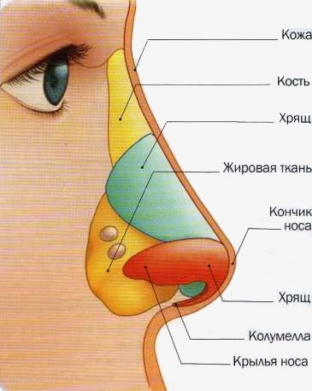It is quite possible to correct some aesthetic defects in the shape of the nose without resorting to surgical intervention. For this, injection rhinoplasty is used. Despite the fact that nose correction with fillers seems to be a simple procedure, it requires a highly qualified doctor, since the injection site is very delicate and carries a high risk of vascular complications. How to choose the right drug and the mode of its administration, which instrument to prefer, and what to do if a complication nevertheless arises, read on estet-portal.com.
Is it possible to combine nose correction with fillers and botulinum toxin?
Injection nose correction can be performed with both fillers and botulinum toxin preparations. Often the administration of these drugs is combined in one procedure, although experts recommend diluting these injections into different sessions if possible.
So, for example, using botulinum toxin injections, you can correct the drooping of the tip of the nose, reduce the width of the nostrils. Next, complete the rotation of the tip with a filler, improve the nasolabial and glabellar angles, correct the slight natural asymmetry of the nose, accentuate the back, and remove a small saddle-shaped fossa.
If nose correction with fillers and botulinum toxin is still carried out in one procedure, it is necessary to distance the injection points as much as possible.
Due to swelling at the injection site, botulinum toxin may not work properly. It is advisable to first inject with botulinum toxin, and after two weeks correct the shape of the nose with fillers.
Read also: The human nose: a brief guide to structure and function
Which tool is preferable to use for nose correction with fillers
 Disputes among specialists about whether to prefer a needle or a cannula for nose correction with fillers have been going on for a long time. On the one hand, cannula work is less traumatic and safer. On the other hand, injection rhinoplasty sometimes requires extremely accurate injection of the drug into a specific area of correction, and the required accuracy can only be achieved with the use of a needle.
Disputes among specialists about whether to prefer a needle or a cannula for nose correction with fillers have been going on for a long time. On the one hand, cannula work is less traumatic and safer. On the other hand, injection rhinoplasty sometimes requires extremely accurate injection of the drug into a specific area of correction, and the required accuracy can only be achieved with the use of a needle.
It is customary to use a cannula to correct the back of the nose, and for targeted work in the area of the nasolabial angle, columella, tip of the nose – take a needle. Experts believe that the use of a needle allows you to more clearly control the depth of drug injection, work in hard-to-reach areas – for example, when injecting through the openings of the nose.
If the experience of correcting the nose with fillers is insufficient, it is better to prefer the cannula – to avoid the risk of vascular complications.
What to do if during the procedure appeared signs of intravascular occlusion
Specialists note the most common cases of intravascular & nbsp; occlusion in nasal tip correction. This zone is very vulnerable due to the poor development of collaterals. In addition, it is recommended to be very careful when correcting the nose with fillers in the columella zone, as well as after injuries, rhinoplasty operations – especially secondary ones.
If signs of thrombosis (increased vascular pattern) appear during the injection of the filler, the procedure should be stopped immediately. Further urgently take the following measures:
- Longidase is immediately injected into the filler injection area and distally,
- Nitroglycerin spray or ointment is applied to each nasal passage,
- a warm compress is applied to the nose.
In an emergency, when there is no time to look for a warm compress, a latex glove filled with warm water can be used.
Read also: How to avoid complications with botulinum toxin therapy
If the nose correction was performed using hyaluronic acid, then in case of signs of ischemia, hyaluronidase (100 & ndash; 300 units) is urgently injected, Derinat is instilled into the nasal passages. Further, the patient is recommended to prescribe inside & nbsp; methyluracil (500 mg 3 times a day for 2 weeks), clarithromycin or another antibiotic (250 mg 2 times a day for 7-10 days), heparin, acetylsalicylic acid may be prescribed, depending on the clinical picture.







Add a comment